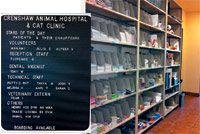Five-minute wellness: Preventive veterinary care that lets the team take charge
This veterinarian's unorthodox system thrilled employees, let doctors focus on medicine and quintupled practice revenue.
In most veterinary clinics, team members are waiting for the doctors' orders. In Henry Yoo's practices, the veterinarians wait for the team's direction.

Dr. Henry Yoo (pictured below) created a five-minute checklist to help his team practice better preventive medicine in five easy steps. PHOTOS COURTESY OF HENRY YOO, DVM
Case in point: When Yoo, DVM, MSc, MBA, asks his receptionist about the upcoming schedule for the day, she basically tells him, "Go away, Dr. Yoo. We can handle it. We'll call you when we need you."
Of course, his staff didn't become this confident overnight. Yoo, now an executive consultant for Infinity Medical Consulting in Santa Monica, Calif., owned four practices in Ohio for 20 years and says in the beginning doctors and team members worked independently as "separate Indian chiefs." Plus, everyone practiced his or her own perception of preventive medicine—the most important type of medicine clinics can implement, Yoo says.

Dr. Yoo keeps brochures in the back-so his team can chose the best ones for each client (right). On his non-traditional staff directory, the doctors are listed last (below). "In our practice, receptionists and technicians are regarded as the top people. They feel very well-respected and it shows in their attitude," Dr. Yoo says.
That's when he decided let the team members run the practice under one aligned system so doctors could focus on client interaction, patient emergencies and treatment. He even created a five-minute checklist to help staff members practice the best preventive medicine possible—and do so efficiently based on his postdoctoral training at The Ohio State University. The checklist is broken down into five easy steps and starts with the receptionist at the front desk. (See a preview of the form at left and head to dvm360.com/preventivechecklist to download the document for your team.)
The checklist reminds the receptionist to cover the predetermined topics on the sheet by asking clients questions such as:
> Does your pet have insurance?
> Does he have a microchip?
> Did he have any blood work done on his last visit?
> Is he due for any vaccinations or a fecal check?
He or she initials the appropriate boxes so the exam room technician knows what topics have been covered. The technician then builds on this discussion by saying something like, "As Judy mentioned at the front desk, let's talk about heartworm prevention. It takes only one mosquito to transfer heartworms to your pet."
During this discussion, the technician also gives the client a brochure on heartworm prevention with the most relevant information circled or highlighted. Yoo says that too often clinics have a handful of brochures on display in the waiting room and it's the client's job to pick them up—and this method is not ideal. His practices have a library full of brochures in the back that the clients never see. It's the doctors' and team members' job to select the best pamphlets for each individual client and case.
"Doctors and team members go into the library and bring back three or four brochures," Yoo says. "They open them up and say, 'Mrs. Jones, this is the one you need to read. Give me a call this afternoon and we can discuss it further.'"
Yoo says the more pet owners know about their pet's problem, the more responsible they become, the more likely they are to comply with the doctor's recommendations and the sooner they notice problems with their pets. "In other words, educated clients become responsible and responsive," Yoo says.
Surprisingly enough, clients actually do the homework when the brochures are customized this way, complete with the doctor's business card stapled to the front. What might be even more surprising? Veterinarians have time for these follow-up calls when they fully utilize their staff.
In hospitals run by Yoo, it's the doctor's job to make a diagnosis and perform certain treatments—team members do everything else allowed by state law. He says doctors practice maximum delegation and sometimes the veterinarians don't have much chance to even touch the needles. After the doctor writes down the treatment plan, technicians take back over. Yoo says the veterinarians are there to support the staff—not the only way around.
"We hear the staff giving the doctors direction all of the time through the paging system," Yoo says. "They point the doctors where to go, which room they need to be in, because they've got it all prepared."
Yoo calls this a "staff-centered practice." He says when team members are given more responsibility they take more pride in their work and have a much stronger relationship with clients. Plus, Yoo says patients live longer with better quality of life when preventive medicine is put into place in their early stages of life.
"Time doesn't easily allow doctors to go into preventive medicine—it can only be successful when staff is involved," Yoo says. "Doctors go into the exam room to deal with an urgent and compelling medical problem: ear infection, protruding eyeball, etc."
So how does Yoo make sure his staff is trained and on board? Once-a-month staff meetings. And he's not talking about an hour block where the doctors tell the staff what to do. Team members take turns leading each of these meetings and focusing on different aspects of preventive medicine. The team member in charge studies his or her topic ahead of time and shares stories about what could happen to a pet that doesn't receive proper preventive medicine—e.g., "Scarlett was behind on this vaccine and contracted parvovirus." When a new drug is released, the team discusses the advantages and disadvantages of the product, and the leader of the meeting can even invite a drug salesperson to speak to the group.
Yoo says it takes a veterinary staff about three to six months of training before they're ready to fully switch gears and take the reins of preventive medicine in a clinic. But boy is it worth it. Yoo recently sold his last veterinary practice and in five years it was bringing in five times the revenue it started with—despite the state of the economy. More importantly, the whole team was more efficient and able to help save more patients.
"A highly empowered team will assist clients and pets through quality care and preventive medicine," Yoo says. "With your support in education and training, staff members can reshape the culture of the practice."